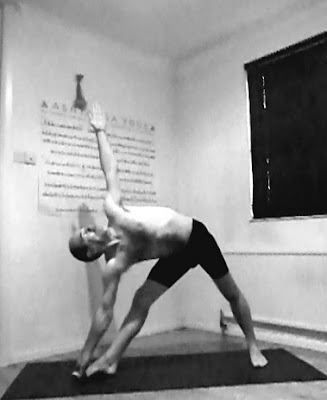"Trikonasana (Figure 4.48)
First, stand following the instructions for tadasana krama. Then, keeping the legs spread no less than 3 mozhams apart, take either arm and lift it straight up, lower the other arm while keeping it straight and bring the hand down and place it on top of the foot. Study this carefully in the picture. The inhalation and exhalation of breath must be equal and slow. Practise this on both sides as described here. This asana must be practised for a minimum of 10 minutes. However slowly and patiently we practise this, there is that much corresponding benefit." Krishnamacharya Yoga Makaranda. ( Mysore 1934)
Krishnamacharya teaching Yvonne Millerand , 1960's a few years after leaving Mysore
Krishnamacharya 1970s in his 80s.
My own practice of Trikonasana.
So hard to find a photo of my practicing Trikonasana, it's as if we are terrified of Iyengar judging us.
Below, one of the only photo's I can find of my practicing trikonasana with my foot to the frount
And here,following my studies with Ramaswami with my feet facing more forward
Later, after focussing more on Krishnamacharya's Yoga Makaranda instruction, including the longer stays I went back to a more Ashtanga approach but with my hand resting lightly on my foot Yoga Makaranda style.
Moving forward......
More recently I'm questioning whether to do trikonasana at all, or rather, whether to include the traditional presentation of the posture in my practice. Simon includes an active movement version in his spinal sequence where the principles of trikonasana are still included. In the video and article below Simon is presenting a version of trikonasana that can act as a preparation/training for a more traditional approach but it has me wondering.... Is it necessary or indeed that beneficial to stay in trikonasana for a significant period as Krishnamacharya suggested or indeed only for a few breaths as Jois presented. Is passing through the activation of the posture in a spinal movement sequence sufficient. Simon teaches both but he seems to be moving more to this "...more of a movement than a stretch" approach.
See this article perhaps: Moving Actively into Postures Can give Strength and Flexibility Without Tension or Stretching
"Active movements are the traditional way to come into yoga postures. These are movements that are done by the muscles that would be used to enter a posture without the assistance of external forces such as gravity, momentum, or one limb pulling on another limb..... Active movements can give you strength without stress, flexibility without painful stretching, and improved circulation without increasing your heart rate". - from the above article
Are the benefits of trikonasana available without staying in the posture for five breaths or ten minutes, by merely passing through an activation of the posture, and if so is passing through the posture once sufficient or is more than one visit required, or perhaps including several variations of related movement/activation. And if this is the case for trikonasana, then what of something like paschimottanasa, where again Krishnamacharya would recommend a long stay and Pattabhi Jois three or four variations of between five and ten breaths each. Is it possible to achieve the same benefits, perhaps more benefit and less possible strain or negative effects by taking a more ....revolutionary approach - every time I see a new video from Simon of his Spinal movements I'm wondering "...where are you taking this?" It seems radical, exciting and yet perhaps there is nothing really so new, perhaps these movements only appear new from the perspective of the static approach to yoga we have now (we may think of Ashtanga as flowing, a moving meditation, but it's still a quite static approach), in other traditions (China?), such movements are perhaps not so strange or revolutionary but rather, quite traditional.
A full presentation of a more traditional approach to trikonasana from Simon and Bianca at yoga Synergy
"Saucha is to clean..., or for me it's to remove the obstacles that block the movement of energy inside us , we need to tense less, stretch less, or move our bodies more balanced...., breathe less...".
A full class with Simon from Love yoga Anatomy
https://loveyogaanatomy.com/tag/simon-borg-olivier/
 |
| from 13:57 - replicating trikonasana |
 |
| from 3:00 trikonasana |
The video below from Yogaanatomy.com includes instruction
Simon's movements in standing remind me of the vinyasas Krishnamacharya presented back in 1938 in his Mysore documentary footage. I'd always assumed Krishnamacharya was just rushing through the movements as a demonstration, but Ramaswami would teach them in a similar way, a ten minute static sirsasana and then another ten minutes of vinyasas/variations....active movements?









